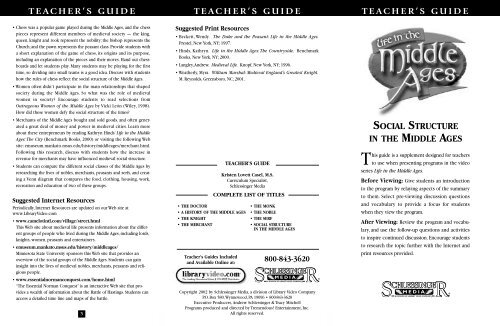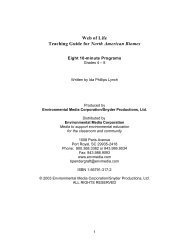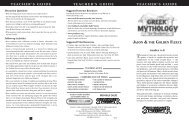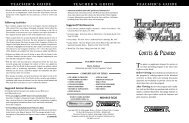teacher's guide teacher's guide teacher's guide - Distribution Access
teacher's guide teacher's guide teacher's guide - Distribution Access
teacher's guide teacher's guide teacher's guide - Distribution Access
Create successful ePaper yourself
Turn your PDF publications into a flip-book with our unique Google optimized e-Paper software.
TEACHER’S GUIDE TEACHER’S GUIDE TEACHER’S GUIDE<br />
• Chess was a popular game played during the Middle Ages, and the chess<br />
pieces represent different members of medieval society — the king,<br />
queen, knight and rook represent the nobility; the bishop represents the<br />
Church; and the pawn represents the peasant class. Provide students with<br />
a short explanation of the game of chess, its origins and its purpose,<br />
including an explanation of the pieces and their moves. Hand out chessboards<br />
and let students play. Many students may be playing for the first<br />
time, so dividing into small teams is a good idea. Discuss with students<br />
how the rules of chess reflect the social structure of the Middle Ages.<br />
• Women often didn’t participate in the main relationships that shaped<br />
society during the Middle Ages. So what was the role of medieval<br />
women in society? Encourage students to read selections from<br />
Outrageous Women of the Middle Ages by Vicki León (Wiley, 1998).<br />
How did these women defy the social structure of the times?<br />
• Merchants of the Middle Ages bought and sold goods, and often generated<br />
a great deal of money and power in medieval cities. Learn more<br />
about these entrepreneurs by reading Kathryn Hinds’ Life in the Middle<br />
Ages: The City (Benchmark Books, 2000) or visiting the following Web<br />
site: emuseum.mankato.msus.edu/history/middleages/merchant.html.<br />
Following this research, discuss with students how the increase in<br />
revenue for merchants may have influenced medieval social structure.<br />
• Students can compare the different social classes of the Middle Ages by<br />
researching the lives of nobles, merchants, peasants and serfs, and creating<br />
a Venn diagram that compares the food, clothing, housing, work,<br />
recreation and education of two of these groups.<br />
Suggested Internet Resources<br />
Periodically, Internet Resources are updated on our Web site at<br />
www.LibraryVideo.com<br />
• www.camelotintl.com/village/street.html<br />
This Web site about medieval life presents information about the different<br />
groups of people who lived during the Middle Ages, including lords,<br />
knights, women, peasants and entertainers.<br />
• emuseum.mankato.msus.edu/history/middleages/<br />
Minnesota State University sponsors this Web site that provides an<br />
overview of the social groups of the Middle Ages. Students can gain<br />
insight into the lives of medieval nobles, merchants, peasants and religious<br />
people.<br />
• www.essentialnormanconquest.com/home.html<br />
“The Essential Norman Conquest” is an interactive Web site that provides<br />
a wealth of information about the Battle of Hastings. Students can<br />
access a detailed time line and maps of the battle.<br />
5<br />
Suggested Print Resources<br />
• Beckett, Wendy. The Duke and the Peasant: Life in the Middle Ages.<br />
Prestel, New York, NY; 1997.<br />
• Hinds, Kathryn. Life in the Middle Ages: The Countryside. Benchmark<br />
Books, New York, NY; 2000.<br />
• Langley,Andrew. Medieval Life. Knopf, New York, NY; 1996.<br />
• Weatherly, Myra. William Marshal: Medieval England’s Greatest Knight.<br />
M. Reynolds, Greensboro, NC; 2001.<br />
• THE DOCTOR<br />
• A HISTORY OF THE MIDDLE AGES<br />
• THE KNIGHT<br />
• THE MERCHANT<br />
Teacher’s Guides Included<br />
and Available Online at:<br />
TEACHER’S GUIDE<br />
Kristen Lovett Casel, M.S.<br />
Curriculum Specialist,<br />
Schlessinger Media<br />
COMPLETE LIST OF TITLES<br />
• THE MONK<br />
• THE NOBLE<br />
• THE SERF<br />
• SOCIAL STRUCTURE<br />
IN THE MIDDLE AGES<br />
S<br />
800-843-3620<br />
MEDIA<br />
R®<br />
A DIVISION OF LIBRARY VIDEO COMPANY ®<br />
CHLESSINGE<br />
Copyright 2002 by Schlessinger Media, a division of Library Video Company<br />
P.O. Box 580,Wynnewood, PA 19096 • 800-843-3620<br />
Executive Producers, Andrew Schlessinger & Tracy Mitchell<br />
Programs produced and directed by Tremendous! Entertainment, Inc.<br />
All rights reserved.<br />
SOCIAL STRUCTURE<br />
IN THE MIDDLE AGES<br />
his <strong>guide</strong> is a supplement designed for teachers<br />
T to use when presenting programs in the video<br />
series Life in the Middle Ages.<br />
Before Viewing: Give students an introduction<br />
to the program by relaying aspects of the summary<br />
to them. Select pre-viewing discussion questions<br />
and vocabulary to provide a focus for students<br />
when they view the program.<br />
After Viewing: Review the program and vocabulary,<br />
and use the follow-up questions and activities<br />
to inspire continued discussion. Encourage students<br />
to research the topic further with the Internet and<br />
print resources provided.<br />
S<br />
MEDIA<br />
R®<br />
A DIVISION OF LIBRARY VIDEO COMPANY ®<br />
CHLESSINGE
Program Summary<br />
Medieval society consisted of multiple types of relationships that provided<br />
organization and structure.The key players in the social structure of the<br />
Middle Ages were the lords, vassals and serfs. One type of relationship that<br />
flourished during this time was called a feudal relationship. In this type of<br />
agreement, lords offered vassals a fief, or something of value, in exchange for<br />
service, usually military in nature.Vassals became sworn followers of a lord<br />
during a ceremony called homage, which formalized the feudal relationship.<br />
Another relationship that was common during this time was forged between<br />
a serf and a lord of the manor. In the context of this arrangement, serfs<br />
worked the lord’s land on a manor, and, in exchange, lords offered serfs protection<br />
and land for them to grow their own food.<br />
Vocabulary<br />
social structure — The pattern of organization of people in a given society.<br />
Middle Ages — Also known as the medieval period, the time period that<br />
stretched roughly from the 5th to the 15th century.The term was coined to<br />
describe the era in between the time of ancient Rome and the Renaissance.<br />
Battle of Hastings — A battle that took place in 1066 to determine the<br />
ruler of England.The English, led by Harold II, were defeated by the Normans,<br />
led by William, Duke of Normandy.<br />
vassals — The sworn followers of a lord.A vassal was often the recipient of<br />
a fief from his lord.<br />
lord — The granter of a fief in exchange for service from a vassal.<br />
Scriptures — Books of the Bible.<br />
homage — The ceremony in which a man became a vassal of a lord.<br />
feudal relationship — The agreement or arrangement between lords and<br />
vassals in which a fief was exchanged for service.<br />
fief — Something of value that was held, but not owned, by a person during<br />
the Middle Ages. People receiving a fief were usually required to offer something<br />
to the lord, the giver of the fief.A fief could be anything of value —<br />
land, public offices or church positions.<br />
nun — A religious woman who takes vows of poverty and service.<br />
merchants — People who buy and sell goods. Merchants can also be skilled<br />
craftsmen who make their own goods and sell them.<br />
serfs — Men or women who were the poorest members of medieval<br />
society. Serfs were peasants who were bound to a lord’s lands and required to<br />
work those lands in exchange for protection from the lord.<br />
effigy — A representation of a person. Some powerful people had effigies<br />
carved on their tombs during the Middle Ages.<br />
manor — An estate owned by the nobility on which serfs worked and to<br />
which they belonged.<br />
(Continued)<br />
lord of the manor — A member of the nobility who was responsible for<br />
the functioning of a manor.<br />
Church — The organization of believers in the Christian religion.<br />
Pre-viewing Discussion<br />
• Discuss with students what they think the term “social structure” means.<br />
Why do they think it would it be important to study the social structure of<br />
a given time period? What do they think social structure can tell them<br />
about the life and times of the people they are studying?<br />
• Encourage students to discuss our modern-day social structure. How is<br />
society organized today? What relationships are common among people in<br />
modern times?<br />
• During the Middle Ages, lords often sought military protection from other<br />
members of the nobility by offering them land. Students can discuss what<br />
this type of relationship can tell them about medieval times.<br />
• Manors were self-sufficient estates that were worked by peasants called<br />
serfs. Some medieval serfs were born on a manor and never left the property.<br />
Encourage students to speculate about what this type of life might<br />
have been like.<br />
Focus Questions<br />
1.Who was William the Conqueror?<br />
2. Define lords and vassals.What was the relationship between these two<br />
groups of people?<br />
3.What was a celebration of homage?<br />
4.Why was it important to have land during the Middle Ages?<br />
5.What was a fief? Provide some examples of fiefs.<br />
6. Give some examples of the services required of vassals.<br />
7.What happened if the feudal relationship was broken off?<br />
8. Define the role of noblewomen during the Middle Ages.What were their<br />
primary responsibilities?<br />
9.Who was William Marshal? What was interesting about his vassalage?<br />
10.What is an effigy, and what might it tell us about medieval people?<br />
11.What was a manor? Who lived on manors during the Middle Ages?<br />
12. Describe the role of the serf on the medieval manor.<br />
13.What role did the Church play in medieval Europe?<br />
Follow-up Discussion<br />
• Encourage students to compare medieval social structure with that of<br />
today’s society. Students can discuss the similarities and differences in the<br />
structure of relationships that make up each of the societies, and how each<br />
of the societies is organized.<br />
(Continued)<br />
2 3<br />
• Relationships in medieval societies were forged among lords, vassals and<br />
serfs.Ask students to discuss which of these groups benefited the most<br />
from their relationships. Students should justify their answers.<br />
• Students can discuss what the pros and cons of the medieval system of<br />
relationships were. Do students feel that this social structure was fair? If<br />
not, how could this social structure have been altered to become more<br />
fair?<br />
• Medieval lords and vassals were predominantly male. Based upon what<br />
students have learned about the Middle Ages, discuss why women did<br />
not often fill these roles in society.<br />
Follow-up Activities<br />
• To become vassals, medieval men swore oaths to their lords in an elaborate<br />
ceremony called homage. Share with students an actual example of<br />
an oath from a medieval homage ceremony from the following Web site:<br />
www.fordham.edu/halsall/source/atton1.html. Students can imagine that<br />
they attended one of these ceremonies, and they can write an eyewitness<br />
account of what this ceremony would be like.<br />
• Imagine with students that a lord and a vassal need to terminate their<br />
feudal relationship because one side did not live up to his obligations.<br />
Students can write a dialog between the two parties, clearly explaining<br />
the reason for the dissolution of the relationship and determining an<br />
outcome. Students can even role-play these interactions for the class.<br />
• In a feudal relationship, a vassal received a fief in exchange for providing<br />
a service to his lord. Students can read an actual list of feudal obligations<br />
required by a medieval lord at the following Web site:<br />
www.fordham.edu/halsall/source/fulbert1.html. Encourage students to<br />
speculate about what obligations they would require of a vassal if they<br />
received one today and to draft a list of feudal obligations. Students<br />
should also brainstorm about what they would offer to a vassal as a fief.<br />
• Have students research the elements of a typical medieval manor, including<br />
the nobles’ manor house, serfs’ homes and land divisions. Using this<br />
information, students can design their own manor layout. (See<br />
go.hrw.com/ndNSAPI.nd/gohrw_rls1/pKeywordResults?ST9%20Medieva<br />
l%20Manor for an example of a layout of a manor.)<br />
• Share with students the laws of William the Conqueror, presented at the<br />
following Web site: www.fordham.edu/halsall/source/will1-lawsb.html.<br />
Encourage students to discuss what these laws tell about this warrior<br />
and society during the Middle Ages. Compare these types of laws with<br />
the laws we have today. How are they similar and different? Which type<br />
of laws would students prefer to follow? Why?<br />
(Continued)<br />
4










